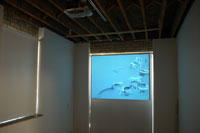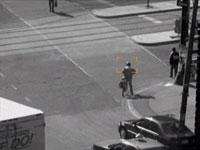John Massey's This Land (The Photographs)
Last week on Thursday (November 17th), i went to see John Massey's new body of work at The Spoke Club on King Street West. It took me some time to find the place, as it was not actually a gallery, but a "private members club" located on the fourth floor. When I finally managed to arrive to the small room where the exhibition was installed, I was surprised to find only six large format photographs hung around a huge couch that barely left any space to look at the pieces.
 The work, however, was definitely worth the trip. Although I thought the photographs were problematic in their approach, the subject matter was very intriguing and innovative. I later found out that the exhibition only included a part of Massey's new piece This Land, and that the whole installation was going to be exhibited in Paris this December.
The work, however, was definitely worth the trip. Although I thought the photographs were problematic in their approach, the subject matter was very intriguing and innovative. I later found out that the exhibition only included a part of Massey's new piece This Land, and that the whole installation was going to be exhibited in Paris this December.Born in 1950 in Toronto, Massey is one of the most famous contemporary Canadian artists. He usually works with installations that mix sculpture, video and photography. During the more recent years he was also known for his use of digital photography and computer technology in his imagery.
I am not too familiar with Massey's previous work. I had the chance to see As the Hammer Strikes, years ago, when I had a growing interest in video art, and I remember being deeply influenced by its mixture of sound and moving images, and its clever installation (three separate projections that almost interact with each other). In comparison, This Land is almost completely different in its digitally perfected and flawless imagery, and more importantly, in its silence.
The exhibition at the Spoke Club included six photographs that showed the interiors of different luxurious cars. Each image was taken from the same vantage point, depicting the driver's seat, the dashboard and the landscape that could be seen through the front and the side windows of the car. The landscapes were perfect representations of the nature, they looked as if they were taken from any stock imagery catalogue. Each one different, and yet the same, they were no different than the cars.
The statement that I found on my way out suggested that Massey was attempting to blur the boundaries between consumer advertisements and aestheticized art. At least for me, this boundary was so blurred that I wasn't able to see the difference between the two. If any of these photographs were placed on a billboard with a car company's logo at the bottom, they would be right at home.
On the other hand, I think the exhibition at the Spoke Club was just a bad decision on Massey's part. The work is clearly incomplete, it lacks a voice. The photographs are silent like the interiors they depict, and whether aestheticized or not, I don't believe art should ever be silent. I have a feeling that the complete body of work that will be exhibited in Paris will include a video piece, or a soundtrack, that would help This Land clarify its point, and distinguish it from advertisement, while maintaining its comment on consumer culture.













